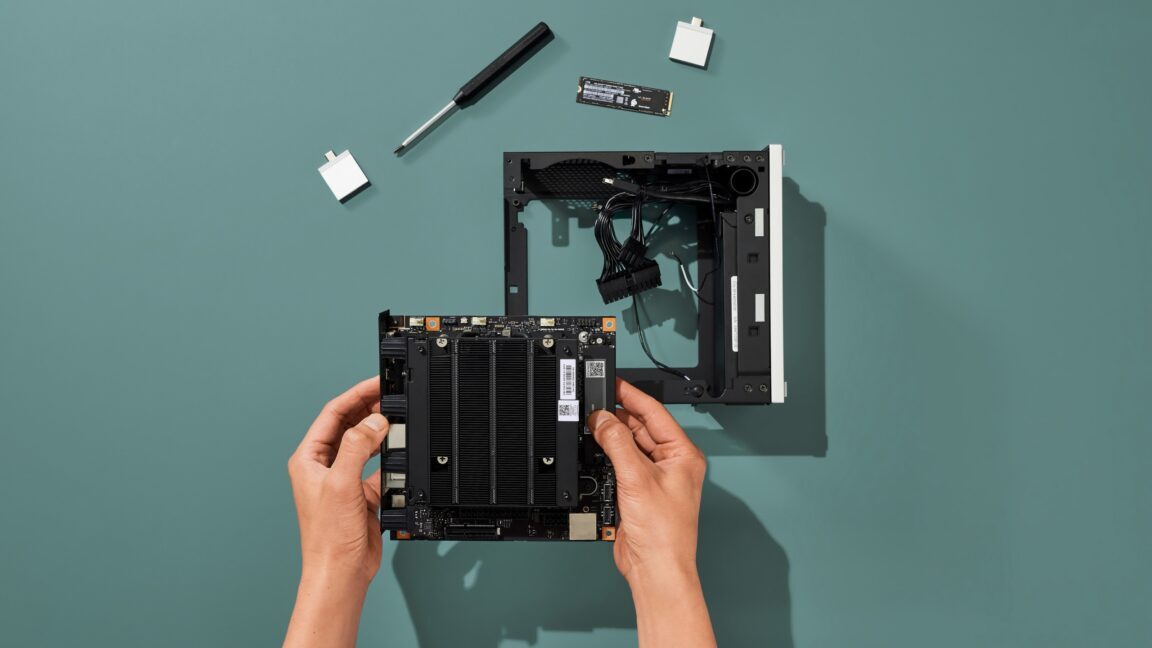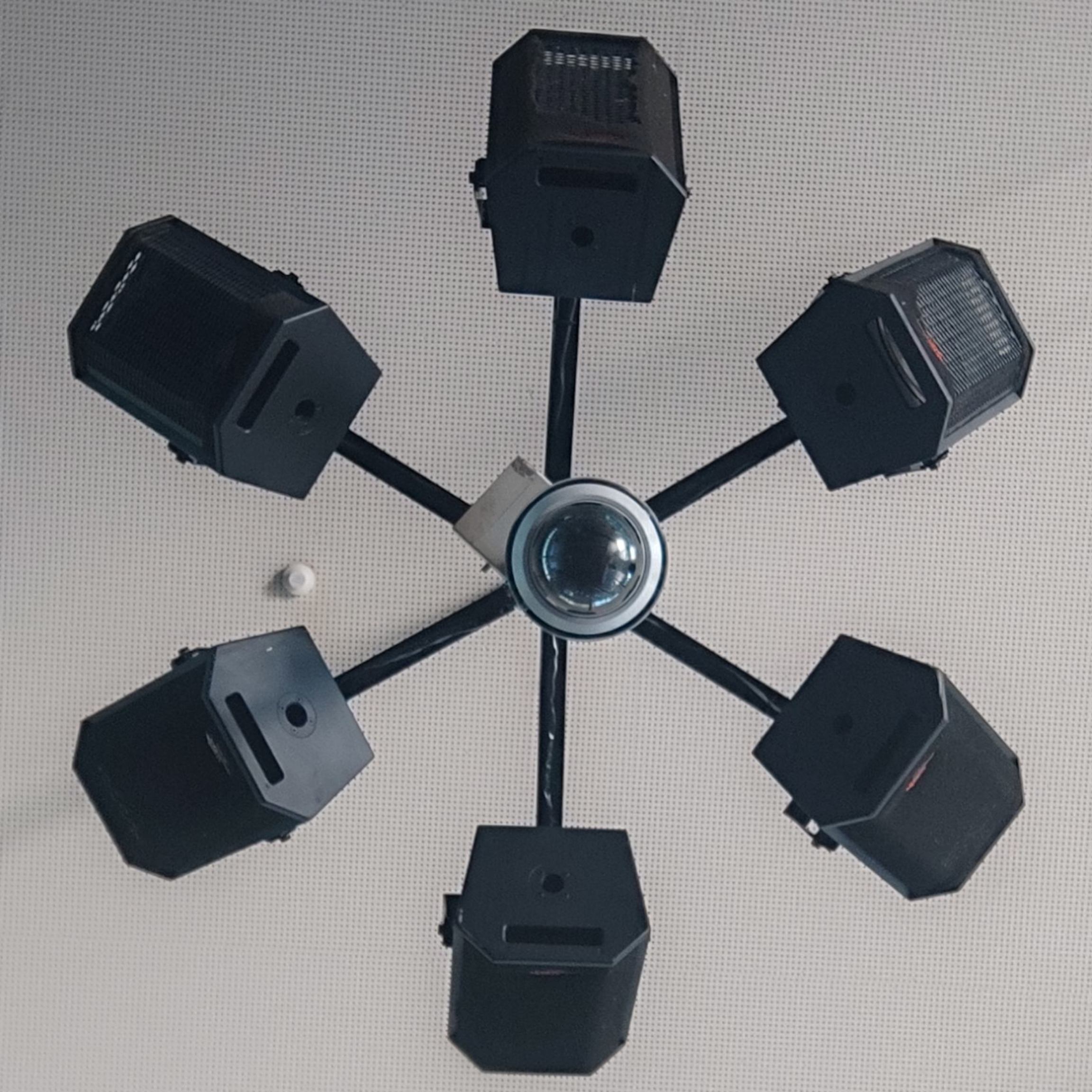- cross-posted to:
- [email protected]
- [email protected]
- [email protected]
- cross-posted to:
- [email protected]
- [email protected]
- [email protected]
This is not really that interesting and kinda weird given the non-upgradability, but I guess it’s good for AI workloads. It’s just not that unique compared to their laptops.
I’d love a mid-tower case with swappable front panel I/O and modular bays for optical drives; would’ve been the perfect product for Framework to make IMO.
They’d be competing with a bajillion other case makers. And I’m pretty sure there are already cases with what you ask (such as 5.25 bay mounted IO running off USB headers, at least).
Like… I don’t really see what framework can bring making a case. Maybe it could be a super SFF mobo with a GPU bay, but that’s close to what they did here.
There may be already such a case but you and me have never heard about it and it’s probably by some chinese no-name brand.
A proper metal mid-tower case with modular front panel I/O (using Framework’s system with the USB-C converters) and modular optical drive/hard drive bays would be unique.
The mini’s are the latest new hotness for desktop computing. I’ve been running a dirt cheap $90US, mini for 2 years now. It fits extremely well on my desk, just tucked in under the monitor leaving plenty of room for all the other tasks I do daily.
Will it play the latest hot new video game? Nope. But it will run OnlyOffice, FreeCAD and FreeDoom just fine.
It’s just not that unique compared to their laptops.
This’ll be a good sell for the useful idiot crowd that has been conditioned to think gaming laptops are the devil.
Xbox with the ability to run windows is what the article is basically saying.
Love the downvotes for saying something that is in the article! Feels just like reddit!
Or linux.
This thing makes a whole lot of pricey workstations obsolete.
I think I need to give Linex a try again. I tried ubuntu in 2008 but found it too difficult to do the things I was used to doing on windows. I now have a bit more coding experience and will probably pick it up quicker
You don’t have to pick and choose, you can dual boot.
But the only thing I boot Windows for these days is gaming and Microsoft Teams. Linux has come a long way since 2008.
teams online client is good enough, too
I will look into it again!
It’s gotten so much better since 2008. Ubuntu is good for servers, but probably not what you’re looking for on a desktop. And you really don’t need to have a coding background to use it, though it also depends on your use case.
I just recall trying to put music on an ipod in ubuntu was a nightmare
Probably still is, lol.
Apple stuff works best in the Apple ecosystem, though most of what works on Windows can work on linux.
Ive long given up on apple! I will do some research!
What kind of workstations?
Any that needs a lot of VRAM and good CPU performance on a budget, but not necessarily the real time performance of a W7900 or whatever.
I really hope this won’t be too expensive. If it’s reasonably affordable i might just get one for my living room.
they already announced pricing for them.
1099 for the base ai max model with 32gb(?), 1999 for fully maxed with the top sku.
Bummer
$1k for the base isn’t horrible IMO, especially if you compare it to something like the mac mini starting at $600 and ballooning over $1k to increase to 32GB of “unified memory” and 1tb of storage.
I get why people are mad about the non-upgradable memory but tbh I think this is the direction the industry is going to go as a whole. They can’t get the memory to be stable and performant while also being removable. It’s a downside of this specific processor and if people want that they should just build a PC
And the “base” of this is physically more like a cut down M4 Pro than a regular M4.
i actually think its not the worst priced framework product ironically. Prebuilt 1k pcs tend to be something like a high end cpu + 4060 desktop anyways, so specs wise, its relatively speaking, reasonable. take for example cyberpower pcs build here, which is of the few oems iirc Gamers Nexus thinks doesn’t charge as much of a SI tax on assembly. it’s acutally not incredibly far off performance wise. I’d argue its the most value Framework product per dollar ironically.
Prebuilt 1k pcs tend to be something like a high end cpu + 4060 desktop anyways
That value proposition evaporates when you factor in repairability and upgradability of those prebuilts.
and if you actually want a PC for gaming on, a discrete gpu (eg: 7900xt) is going to be at least 3x faster at throwing polygons around than the 8060S. This thing is definitely better for AI workloads than gaming.
With a cheeky comparison to Apple’s nearly $5k offering.
Lmao the news about this desktop is strangling their website to the point of needing a 45 minute waiting list
The Lemmy Lick strikes again!
Guilty. This thing came out at the perfect time and I was considering building my own or a Mac mini but this has 95% of what I’m looking for for less than a spec compromised Mac mini. So I preordered. And I kept hitting refresh lol.
I always think the Mac mini is just a bit too mini. It’s a desktop so it’s not exactly going to be moved around a lot so it doesn’t need to be quite that tiny and this thing is a good compromise between still being small but without being so small that it offers no upgradability.
And I know Apple says otherwise but surely that thing must get thermally throttled at some point.
They did announce three major products today.
Yeah that touchscreen tablet convertible machine is what has me psyched. I’m not the target for it, and already own a 16, but I could see that thing selling well. I honestly think they came out with the desktop because they just kinda felt they needed a desktop.
I have a 16 and a 13, I thought I’d give away the 13 when I got the 16 but I keep using the 13 as well cause of how portable it is. Lot nicer to lounge about with the 13 than the 16.
I might get the 12 to replace my 13 and use it for drawing practice and web browsing. Performance wise it’d be a downgrade from my 1280p but I don’t really need the performance.
I visited their website literally within about 10 minutes of them announcing the product and I had to wait 8 minutes to get in.
If framework has, or had, one problem, it was that the main appeal of their products was the repairability, the products themselves were only okay in terms of specs. Well now they have really decent specs as well.
I could absolutely see schools wanting to deploy these to their students.
Framework releasing a Mac Mini was certainly not on my bingo card for this year.
Ok, should I know who framework is? I’ve been a PC gamer since forever and I’ve never heard of this company.
.
They make repairable laptops.
repairable and upgradable*
I know it’s an absolutely banal nitpick, but I think it’s unfortunately a revelation in the current laptop market that ~90% of a laptop stays good for a really really long time, and the other 10% can be upgraded piecemeal as the need arises. Obviously this was never news to the Desktop world, but laptop manufacturers got away with claiming this was impossible for laptops in the name of efficiency and portability.
I wasn’t prepared. I’ve been eyeing a mini for a while and this thing kills it on value compared to what I would get in a similar price point.
What alternatives were you considering, and how does the product from Framework compare?
Mac mini and studio. The overall power comparison remains to be seen but cost to spec ratio I would have had to spend over 6k and couldn’t have 16tb of memory, frameworks was around 3200.
So… now Framework Corp is selling non-upgradable hardware?
I dunno. Conceptually I want to like Framework. But their pricing means it is basically never worth buying and upgrading versus just buying a new laptop (seriously, run the numbers. You basically save 10 bucks over two generations of shopping at Best Buy). But they also have a system that heavily encourages people to horde spare parts rather than just take it to an e-waste disposal facility/bin.
It will be faster than most next-gen laptops, and it’s much cheaper than a similarly-specced Asus Z13. Strix Halo uses a quad channel 8533Mhz bus, 2 full Zen CCDs like you find in desktops/servers, and a 40 CU GPU. Its more than twice the size/performance of two true “laptop chips” put together.
Everything except the APU/RAM/Mobo combo is upgradable, and you don’t have to replace the whole machine if the board fails.
I mean, if you don’t need that kind of compute/RAM, this system is not for you, and old gaming desktops are probably better deals for pure gaming. But this thing has a niche.
I think the framework desktop would be an absolute powerhouse as a workstation desktop.
Think developers ( that still use desktops ), people who do raw computational power for science, servers, ai development, …Everything except the APU/RAM/Mobo combo is upgradable, and you don’t have to replace the whole machine if the board fails.
So… storage, case, and USB C dongles?
Fans, case, ports, side panel, …
Whatever you do with a pc, you can do with this.
Just not separately replace ram and cpu because of the cpu design of amd.Hell, it can be connected to another one to make on hell of a compute monster too.
A PC lets you replace the CPU, ram and plug in multiple pcie cards.
This is less upgradable than the average laptop.
Oh. Okay. As long as I can replace the side panel.
You can change the squares on the front panel!!!
/s
their pricing means it is basically never worth buying and upgrading versus just buying a new laptop (seriously, run the numbers. You basically save 10 bucks over two generations of shopping at Best Buy).
Maybe so. But the big difference is, you can upgrade iteratively rather than taking the entire hit of a new device all at once. So I can buy all of the individual components of my next laptop a few hundred dollars at a time over the course of a couple of years, and use them as I get them. By the time I’ve ship-of-theseus’d the whole device, I may have spent the same amount of money on that new computer, but I paced it how I wanted it. Then I put all of the old components into an enclosure and now I can use it as a media center or whatever. Plus, if something breaks, I can fix it.
What exactly can you upgrade iteratively?
From the laptop perspective (because the desktop is totally all about that side panel life):
- Memory: Ultrabooks are hell, no arguments there. But many brands have increasingly allowed at least one SODIMM to be swapped out and many still no longer solder the other one. And I’ll say, from personal experience, that buying and swapping out RAM in a relatively new-ish laptop often comes out closer to the price of just paying for the upgraded SKU to begin with. So there is the logic of “I’ll add another 16 GB in two years” but… yeah.
- Storage: Again, same. Except that they tend to not even solder down the nvmes. There are some particularly asshole vendors but they are few and far between. And this totally is worth doing since they tend to be fairly standard nvme drives or the small SSD that I always forget the format of. Rather than RAM that is only used by laptops and NUCs and costs an arm and a leg…
- Ports: Framework laptops just use USB C dongles for everything. They have a semi-proprietary format for those but it is still, fundamentally, a usb c dongle. And, from talking to a mutual on a discord who has one, it has the same fundamental problem that USB C dongles/hubs do when installing the more finicky OSes (hi Proxmox and OpnSense) where you can’t actually access the hub capabilities until AFTER the OS is installed (the more live CD based distros avoid this). So no difference in terms of upgrades and modularity outside of having fewer vendors to buy a dongle from if you care about form factor that much.
- CPU: Only if you swap out the motherboard which is the vast majority of the price of the laptop anyway.
- Keyboard, display, etc: These are less “upgrades” so much as replacements. Which are good arguments for repairability but also… go actually look at ifixit’s website and see how many laptops are repairable. It is mostly just apple who suck horrifically
And just because it always amuses me and never fails, let’s price out upgrading/replacing a framework (uplacing?). I’ll assume no parts failed to keep prices simple and “You can replace your keyboard every time it fails over a five year period” is not the flex people think it is. I’ll use the intel core ultra series 1 because that is in stock and not a preorder. We are dealing with last year’s model (I think. I haven’t followed Intel laptop processors too much) so there is inherently wiggle room there, but it is theoretically fair as it is last year’s model for both of them since I had to dig deep into the framework site to find an Intel since fuck Best Buy’s website if you are trying to compare AMDs (also fuck AMD for their naming insanity).
- FW13 with Intel Core Ultra Series 1 at 13 inches is estimated to be 999 USD https://frame.work/products/laptop13-intel-ultra-1/configuration/new. 8 Gigs of RAM, Ultra 5 125H, 256 GB Storage
- Core Ultra 5 Series 1 at 13 inches. Ultra 5 125U so techincally different but arguably much better for an actual laptop. 256 GB storage, 8 GB RAM. … Eothas wept at this URL https://www.bestbuy.com/site/hp-probook-460-g11-16-ips-1920-x-1200-wuxga-laptop-intel-core-ultra-5-with-8gb-memory-256-gb-ssd-pike-silver-aluminum-gray/6601496.p?skuId=6601496. Estimated to be 879.99 USD
So we are already looking at the framework being about 120 USD more expensive without looking at any configurations or upgrades.
So let’s get into that hyperbolic time chamber and totally not have gay sex with the glistening man hunk known as Vegeta. Five years later, let’s consider an upgrade… to the same SKU.
On the Framework marketplace, another 125H mobo costs 399 USD right now.
- Framework:
999 + 399 = 1398for two generations of a laptop - Best Buy:
879 + 879 = 1758 - For a total savings of
1758-1398 = 360USD over 5 years of getting soaked by that galick gun
Which is nothing to balk at. But that assumes that your display and keyboard held up and didn’t need replacing, you liked all the default dongles Framework gave you (which is apparently just four USB C ports… to plug into the four USB C ports on the laptop), and, most importantly, that Framework didn’t change their form factor (I am not sure if they did for the 16 inch laptops to support the “modular” keyboards). Every spare dongle or repaired/upgraded part costs money. Versus being guaranteed a “pristine” new laptop… full of massive amounts of bloatware that you immediately format the shit out of to put Linux on that.
And, obvious grain of salt, the past few times I have done this exercise it was closer to 100 USD. Framework just happen to be dumping large amounts of old stock right now for their new models so the prices are better and the comparisons are more tedious.
Again, conceptually I like Framework. And, for as much as I mock them, I actually do like the form factor for their dongles a lot. Give me a computer with a shit ton of USB C ports but also let me leep it usable at work without needing to carry around my sketchy anker dongle/dock. And I don’t really fault them too much for not letting you actually swap CPUs since that was basically something only the sickest of sickos did until the AM4 socket lasted like 40 years somehow.
But their key strength is marketing and that has only gotten stronger since they got the full power of linus media group behind them because that company needs to protect their shareholders’ investment.
And, like I said before, I do worry that this just encourages people to hoard parts. Like… anyone who has built a desktop or two has that big plastic bin full of old ram and mobos and even graphics cards that they might use someday but never will (PSU is totally worth saving though).
What exactly can you upgrade iteratively?
At the price point, being able to upgrade memory, storage, and motherboard is unique. And I know you say that it’s the “vast majority” of the cost, but I just bought a Framework 13 last month (I know, great timing) and the mainboard was right around half the total cost. So sure, the most expensive single component, but it means that I can upgrade to a better-performing machine in the future for half the price and not need to junk everything else.
Framework laptops just use USB C dongles for everything.
Correct. But honestly, having the swappable I/O is fantastic; over the last five laptops I’ve owned, I’ve only upgraded because I wanted new capabilities once. For the other four, it’s because a component failed; and in two of them it was a USB port, while in a third it was a charging port. Being able to replace those would have extended the lives of those machines substantially.
fewer vendors to buy a dongle from
Actually, they’re open-source (not proprietary). And since they’re USB-C, you could probably just take out the card and plug a dongle right in there if you really needed to (I have not tried this).
Framework: 999 + 399 = 1398 for two generations of a laptop
I’m planning to hold on to this device for a whole lot longer than two generations. If I can, I’d like to hang on to it for 15-20 years. The laptop I upgraded from was five years old or so (and would still be going strong if it didn’t have a port that was about to die and un-upgradeable RAM and storage), and my desktop is 13 years old and still going strong, so this isn’t terribly unreasonable. I would estimate that I’ll end up pouring about $2000, all told, into this laptop over that time period, likely replacing 3-4 laptop purchases and giving me a better machine during that time period.
that assumes that your display and keyboard held up and didn’t need replacing,
Both of which would be cheaper than a new device. A new display is $150 and a new keyboard is $30. I don’t know about the longevity of each component, but based on the research I did it’s definitely not worse than an off-the-shelf machine.
you liked all the default dongles Framework gave you (which is apparently just four USB C ports… to plug into the four USB C ports on the laptop),
There aren’t any defaults. When you spec out your kit, you choose which cards to purchase. Replacing them costs about $10. (EDIT: The USB-C ones cost $10. The other ones are variously priced between $10-40, and then there are some storage expansions that cost more because they’re basically SSD in the expansion card form factor).
and, most importantly, that Framework didn’t change their form factor
They’ve only done that once since they launched, across six updates to the components. When they made that upgrade, they offered a $90 top cover to bring first gen devices up to second gen specs.
(I am not sure if they did for the 16 inch laptops to support the “modular” keyboards).
There’s only been one generation of the 16 inch laptops, and they’ve always had the modular keyboards. The refresh they announced yesterday is just to components, not to chassis.
Every spare dongle or repaired/upgraded part costs money.
Yep, and I’m fine with that because it means that I can spec it out the way I want; I don’t have to pay for I/O that I’ll never use. My old laptop had an SD card reader and a DisplayPort output; I literally never used either. The one I had before it had a SATA connector on the external I/O, and a couple of other pieces of nonsense that I didn’t want or need. Actually, thinking back, I don’t know if I’ve ever owned a laptop (until this one) where I actually used all of the ports.
And I don’t really fault them too much for not letting you actually swap CPUs since that was basically something only the sickest of sickos did
Yeah, I think swappable CPUs on a laptop are a thing of the past. I hope I’m wrong, but I just don’t see it coming back.
I do worry that this just encourages people to hoard parts
I DON’T HAVE A PROBLEM
I CAN STOP WHENEVER I WANT TO
No, the pc is upgradable. They explicitly said in the event that the desktop was suppose to be an actual desktop with replaceable parts as much as technically possible. Only ram is tied to the mobo/cpu because of technical limitations of the amd cpu
At least memory is soldered on because of high throughout they say.
You get fast memory as a result. If you don’t care about the fast memory, there’s no good reason to buy this, with their motherboard. There’s a use case this serves which can’t be served by traditional slotted memory and the alternative is to buy 4-5 NVIDIA 3090/4090/5090. If you want that use case, then this is a pretty good deal.
And your phone isn’t repairable because it needs to be water proof. Your earbuds because of power efficiency. Etc.
Also, I suggest watching this https://www.youtube.com/watch?v=K3zB9EFntmA.
But, to be clear: I am actually not as opposed to the idea of soldered ram when you have “an excuse”. Same with phones. But framework is a brand that tries to build itself on minimizing e-waste and maximizing repairability and… hey, at least we can still swap out the side panel on their prebuilt!
As far as I read LPCAMM in its current state does not work for this. The electrical noise is too high. These things aren’t the same. A repairable waterproof phone can be made without glue by making it a bit thicker. In the case of RAM today, we’re hitting fundamental physics limitations with speed of electricity and noise. At this point the physical interconnect itself becomes a problem. Gold contact points become antennas that induce noise into adjacent parts of the system. I’m not trying to excuse Framework here. I’m saying that the difficulty here borders on the impossible. If this RAM was soldered and it had bandwidth no different than SODIMM or LPCAMM modules then I’d say Framework fucked up making it soldered, majorly. As I said, there’s no point buying this if you don’t care about the fast RAM and use cases that need it like LLMs. Regular ITX board with regular AM5 is the way to go.
E: To be clear, if this bandwidth could be achieved with LPCAMM, then Framework fucked up.
Holy moly this is awesome! I am in for the 128GB SKU.
That’s 96GB of usable VRAM! And way more CPU bandwidth than any desktop Zen chip.
I know people are going to complain about non upgradable memory, but you can just replace the board, and in this case it’s so worth it for the speed/power efficiency. This isn’t artificial crippling, it physically has to be soldered, at least until LPCAMM catches on.
My only ask would be a full X16 (or at least a physical X16/electrical x8) PCIe slot or breakout ribbon. X4 would be a bit of a bottleneck for some GPUs/workloads… Does Strix Halo even support that?
I understand the memory constraints but it does feel weird for framework, is all I have to say. But that’s also the general trajectory of computing from what it seems. I really want lpcamm to catch on!
Eventually most system RAM will have to be packaged anyway. Physics dictates that one pays a penalty going over pins and mobo traces, and it gets more severe with every advancement.
It’s possible that external RAM will eventually evolve into a “2nd tier” of system memory, for background processes, spillover, inactive programs/data, things like that.
That would be fine. But as long as it can use it as RAM and not just a staging ground.
Keep in mind that it would be pretty slow, as it doesn’t make sense to burn power and die area on a wide secondary bus.
It’s already fourth tier after L1, L2, L3 caches.
Maybe something like optane will make a comeback. Having 16gb of soldered RAM and 500gb of relatively slow, but inexpensive optane RAM would be great.
DRAM is so cheap and ubiquitous that they will probably keep using that, barring any massive breakthroughs. The “persistence after power-off” is nice to have, but not strictly needed.
deleted by creator
Apparently Framework did try to get AMD to use LPCAMM, but it just didn’t work from a signal integrity standpoint at the kind of speeds they need to run the memory at.
Sounds like it doesn’t bode well for the future of DIMMs at all, TBH.
My AM5 system doesn’t post with 128GB of 5600 DDR5 at higher than 4400 at JEDEC timings and voltage. 2 DIMMs are fine. 4 DIMMs… rip. So I’d say the present of DIMMs is already a bit shaky. DIMMs are great for lots of cheap RAM. I paid a lot less than what I’d have to pay for the equivalent size of RAM in a Framework desktop.
You have a DIMM view of the future.
but you can just replace the board
The board is like, the whole computer tho. The mobo, CPU, GPU and RAM are all the same component. It’s everything Framework is supposed to oppose. That took them what, 4 years? to throw away their values?
They also announced three other products (one new, two refreshes) which are still being actively developed and are fully-modular devices at low cost. If they’re “throwing away their values,” they’re not doing it very well.
It’s never a single step process. These things happen slowly, bit by bit. It’s the beginning of the end.
If this is it happening bit by bit, then why is most of the news about them doubling down on their principles? Why did they make clear what they were doing and why, and talk about their work to make it modular, instead of trying to hide it or sweep it under the rug?
This sort of doomerism and slippery slope purity test nonsense is exactly why niche companies that do what people value eventually go under, leaving us with just the awful ones. This isn’t a betrayal of their values. This isn’t the beginning of the end. It’s just a choice they made, and all of the other choices they made confirm that they’re still doing stuff the way they were.
Edit: I’m not saying you have to buy it, or that you shouldn’t make clear to the company you don’t think this comports with what you want them to value. But writing them off forever based on this one product seems so self-defeating.
If this is it happening bit by bit, then why is most of the news about them doubling down on their principles?
Its called marketing.
Why did they make clear what they were doing and why
…I don’t understand the question. Why wouldn’t they? Why does being clear about why they’ve abandoned their mission excuse anything?
exactly why niche companies that do what people value
That’s the opposite of what’s happening though.
Its called marketing.
They’re actually building those devices. It’s not marketing if you can buy them.
Why wouldn’t they?
Because most companies do. They gloss over the shifts so that they can focus on other stuff.
Why does being clear about why they’ve abandoned their mission excuse anything?
Because it shows that they haven’t. They talked about the work they put into trying to make it modular.
That’s the opposite of what’s happening though.
For this one product, maybe. But again, this was one of the four products they announced yesterday.
It’s not marketing if you can buy them.
…yes? It is? Why would you market a product that no one can buy? LOL
Because most companies do.
And that means they should?
They talked about the work they put into trying to make it modular.
“Aw sorry, we really tried to make something” doesn’t cut it. If you can’t do it, don’t do it. Simple as.
But again, this was one of the four products they announced yesterday.
How many products that are antithetical to their entire stated purpose do they need to make before you see that as a red flag?
It’s what happens when you go through rounds of funding.
How did you get from 128 GiB of RAM, as the reported specs, to 96 VRAM ?
“VRAM” has to be allocated to the integrated GPU in the BIOS, and reports (and previous platforms) suggest the max one can allocate is 96GB, or 3/4 of it.
What’s a SKU? Google just says “Stock Keeping Unit”, but I don’t think that’s correct in this context.
As others said.
In this context it would be one of the CPU/Memory combinations framework offers: https://en.wikipedia.org/wiki/List_of_AMD_Ryzen_processors#Strix_Halo_(Zen_5/RDNA3.5/XDNA2_based)
It’s correct. A product with various options will have each combination of options under a different SKU. It’s a singular number that identifies an exact version of a product.
its used to mean a new product that you specifically have to keep track of. e. g if you found framework desktops in a store, it wouldnt all be sold under 1 sku. all 3 ram capacities would be 3 different bar codes
a new product
not only new
Basically another word for ‘Product Number’ or ‘P/N’ for short.
In this context, SKU refers to a variant of this product. That is the correct acronym as I understand
I feel like this is a big miss by framework. Maybe I just don’t understand because I already own a Velka 3 that i used happily for years and building small form factor with standard parts seems better than what this is offering. Better as in better performance, aesthetics, space optimization, upgradeability - SFF is not a cheap or easy way to build a computer.
The biggest constraint building in the sub-5 liter format is GPU compatibility because not many manufacturers even make boards in the <180mm length category. Also can’t go much higher than 150-200 watts because cooling is so difficult. There are still options though, i rocked a PNY 1660 super for a long time, and the current most powerful option is a 4060ti. Although upgrades are limited to what manufacturers occasionally produce, it is upgradeable, and it is truly desktop performance.
On the CPU side, you can physically put in whatever CPU you want. The only limitation is that the cooler, alpenfohn black ridge or noctua l9a/l9i, probably won’t have a good time cooling 100+ watts without aggressive undervolting and power limits. 65 watts TDP still gives you a ryzen 7 9700x.
Motherboards have the SFF tax but are high quality in general. Flex ATX PSUs were a bit harder to find 5 or 6 years ago but now the black 600W enhance ENP is readily available from Velkase’s website. Drives and memory are completely standard. m.2 fits with the motherboard, 2.5in SATA also fits in one of the corners. Normal low profile DDR5 is replaceable / upgradeable.
What framework is releasing is more like a laptop board in a ~4 liter case and I really don’t like that in order to upgrade any part of CPU, GPU or memory you have to replace the entire board because it’s soldered on APU and not socketed or discrete components. Framework’s enclosure hasn’t been designed to hold a motherboard+discrete GPU and the board doesn’t have a PCIe slot if you wanted to attach a card via riser in another case. It could be worse but I don’t see this as a good use of development resources.
I think the biggest limiting factor for your mini PC will always be the VRAM and any workload that enjoys that fast RAM speed. Really, I think this mini PC from framework is only sensible for certain workloads. It was poised as a mobile chip and certainly is majorly power efficient. On the other hand I don’t think it is for large scaling but more for testing at home or working at home on the cheap. It isn’t something I expected from framework though as I expected them to maintain modularity and the only modularity here is the little USB cards and the 3D printed front panel designs lol
Edit
Personally I am in that niche market of high RAM speed. Also, access to high VRAM for occasional LLM testing. Though it is an AMD and I don’t know if am comfortable switching from Nvidia for that workload just yet. Renting a GPU is just barely cheap enough.
So can someone who understands this stuff better than me explain how the L3 cache would affect performance? My X3D has a 96 MB cache, and all of these offerings are lower than that.
This has no X3D, the L3 is shared between CCDs. The only odd thing about this is it has a relatively small “last level” cache on the GPU/Memory die, but X3D CPUs are still kings of single-threaded performance since that L3 is right on the CPU.
This thing has over twice the RAM bandwidth of the desktop CPUs though, and some apps like that. Just depends on the use case.
and some apps like that.
I’d wager a guess: AI?
Honestly CPUs are bad for AI, especially in this case where there’s a GPU on the same bus anyway.
Of the top of my head, video encoding and compression/decompression really likes raw memory bandwidth. Maybe some games? Basically, wherever the M Pro/Max CPUs are really strong compared to the base M, these will excel in the same way.
Now, can we have a cool European company doing similar stuff? At the rate it’s going I can’t decide whether I shouldn’t buy American because I don’t want to support a fascist country or because I’m afraid the country might crumble so badly that I can’t count on getting service for my device.
I could envision MNT Research trying this in the future, but not for now.
Wow, that stuff looks awesome! Thanks for sharing 🙏
Wait I thought they were a Taiwanese company?
This comment made me double check. They’re from San Francisco: https://en.m.wikipedia.org/wiki/Framework_Computer
I’d prefer to buy taiwanese tbh. 😉
Much like their laptops, I’m all for the idea, but what makes this desirable by those of us with no interest in AI?
I’m out of that loop though I get that AI is typically graphics processing heavy, can this be taken advantage of with other things like video rendering?
I just don’t know exactly what an AI CPU such as the Ryzen AI Max offers over a non-AI equivalent processor.
I hate how power hungry the regular desktop platform is so having capable APUs like this that will use less power at full load than a comparable CPU+GPU combo at idle, is great, though it needs to become a lot more affordable.
Production costs are not low either, and AMD still needs to profit. AMD’s APUs are already very affordable.
Much like their laptops
Its nothing like their laptops, thats the issue :/ Soldered in stuff all around, nonstandard parts that make it useless for use as a standard PC or gaming console.
Sorry, I was stating that “much like their laptops, I like the idea of these desktops.” I was not trying to insinuate that they themselves are alike.
There’s lots of workstation niches that are gated by VRAM size, like very complex rendering, scientific workloads, image/video processing… It’s not mega fast, but basically this can do things at a reasonable speed that you’d normally need a $20K+ computer to even try. Like, if something takes hours on an A6000 Ada or an A100, just waiting overnight on one of these is not a big deal. Cashing or failing to launch on a 4090 or 7900 XTX is.
That aside, the IGP is massively faster than any other integrated graphics you’ll find. It’s reasonably power efficient.
what makes this desirable by those of us with no interest in AI?
Juat maybe not all products need to be for everyone.
Sometimes it’s fine if a product fits your label of “Not for me”.There is a massive push right now for energy efficient alternatives to nvidia GPUs for AI/ML. PLENTY of companies are dumping massive amounts of money on macs and rapidly learning the lesson the rest of us learned decades ago in terms of power and performance.
The reality is that this is going to be marketed for AI because it has an APU which, keeping it simple, is a CPU+GPU. And plenty of companies are going to rush to buy them for that and a very limited subset will have a good experience because they don’t have time sensitive operations.
But yeah, this is very much geared for light-moderate gaming, video rendering, and HTPCs. That is what APUs are actually good for. They make amazing workstations. I could also see this potentially being very useful for a small business/household local LLM for stuff like code generation and the like but… those small scale models don’t need anywhere near these resources.
As for framework being involved: Someone has kindly explained to me that even though you have to replace the entire mobo to increase the amount of memory, you can still customize your side panels at any moment so I guess that is fitting the mission statement.
For modularity: There’s also modular front I/O using the existing USB-C cards, and everything they installed uses standard connectors.
Not really sure who this is for. With soldered RAM is less upgradeable than a regular PC.
AI nerds maybe? Sure got a lot of RAM in there potentially attached to a GPU.
But how capable is that really when compared to a 5090 or similar?
The 5090 is basically useless for AI dev/testing because it only has 32GB. Mind as well get an array of 3090s.
The AI Max is slower and finicky, but it will run things you’d normally need an A100 the price of a car to run.
But that aside, there are tons of workstations apps gated by nothing but VRAM capacity that this will blow open.
… but only OpenCL workloads, right?
Not exactly. OpenCL as a compute framework is kinda dead.
What types of compute can you run on an AMD GPU today?
Most CUDA or PyTorch apps can be run through ROCM. Your performance/experience may vary. ZLUDA is also being revived as an alternate route to CUDA compat, as the vast majority of development/intertia is with CUDA.
Vulkan has become a popular “community” GPU agnostic API, all but supplanting OpenCL, even though it’s not built for that at all. Hardware support is just so much better, I suppose.
There are some other efforts trying to take off, like MLIR-based frameworks (with Mojo being a popular example), Apache TVM (with MLC-LLM being a prominent user), XLA or whatever Google is calling it now, but honestly getting away from CUDA is really hard. It doesn’t help that Intel’s unification effort is kinda failing because they keep dropping the ball on the hardware side.
No, it runs off integrated graphics, which is a good thing because you can have a large capacity of ram dedicated to GPU loads
Useless is a strong term. I do a fair amount of research on a single 4090. Lots of problems can fit in <32 GB of VRAM. Even my 3060 is good enough to run small scale tests locally.
I’m in CV, and even with enterprise grade hardware, most folks I know are limited to 48GB (A40 and L40S, substantially cheaper and more accessible than A100/H100/H200). My advisor would always say that you should really try to set up a problem where you can iterate in a few days worth of time on a single GPU, and lots of problems are still approachable that way. Of course you’re not going to make the next SOTA VLM on a 5090, but not every problem is that big.
Exactly, 32 is plenty to develop on, and why would you need to upgrade ram? It was years ago I did that in any computer let alone a tensor workstation. I feel like they made pretty good choices for what it’s for
Fair. True.
If your workload/test fits in 24GB, that’s already a “solved” problem. If it fits in 48GB, it’s possibly solved with your institution’s workstation or whatever.
But if it takes 80GB, as many projects seem to require these days since the A100 is such a common baseline, you are likely using very expensive cloud GPU time. I really love the idea of being able to tinker with a “full” 80GB+ workload (even having to deal with ROCM) without having to pay per hour.
This is my use case exactly.
I do a lot of analysis locally, this is more than enough for my experiments and research. 64 to 96gb VRAM is exactly the window I need. There are analyses I’ve had to let run for 2 or 3 days and dealing with that on the cloud is annoying.
Plus this will replace GH Copilot for me. It’ll run voice models. I have diffusion model experiments I plan to run but are totally inaccessible locally to me (not just image models). I’ve got workloads that take 2 or 3 days at 100% CPU/GPU that are annoying to run in the cloud.
This basically frees me from paying for any cloud stuff in my personal life for the foreseeable future. I’m trying to localize as much as I can.
I’ve got tons of ideas I’m free to try out risk free on this machine, and it’s the most affordable “entry level” solution I’ve seen.
And even better, “testing” it. Maybe I’m sloppy, but I have failed runs, errors, hacks, hours of “tinkering,” optimizing, or just trying to get something to launch that feels like an utter waste of an A100 mostly sitting idle… Hence I often don’t do it at all.
One thing you should keep in mind is that the compute power of this thing is not like an A/H100, especially if you get a big slowdown with rocm, so what could take you 2-3 days could take over a week. It’d be nice if framework sold a cheap MI300A, but… shrug.
I don’t mind that it’s slower, I would rather wait than waste time on machines measured in multiple dollars per hour.
I’ve never locked up an A100 that long, I’ve used them for full work days and was glad I wasn’t paying directly.
Yeah, I agree that it does help for some approaches that do require a lot of VRAM. If you’re not on a tight schedule, this type of thing might be good enough to just get a model running.
I don’t personally do anything that large; even the diffusion methods I’ve developed were able to fit on a 24GB card, but I know with the hype in multimodal stuff, VRAM needs can be pretty high.
I suspect this machine will be popular with hobbyists for running really large open weight LLMs.
I suspect this machine will be popular with hobbyists for running really large open weight LLMs.
Yeah.
It will probably spur a lot of development! I’ve seen a lot of bs=1 speedup “hacks” shelved because GPUs are fast enough, and memory efficiency is the real bottleneck. But suddenly all these devs are going to have a 48GB-96GB pool that’s significantly slower than a 3090. And multimodal becomes much more viable.
Not to speak of better ROCM compatibility. AMD should have done this ages ago…
Not really sure who this is for.
Second sentence in the linked article.
To anyone complaining about non-replaceable RAM: This machine is for AI, that is why.
Think of it like a GPU wirh a CPU on the side, vs the other way around.
Inference requires very fast ram transfer speed, and that is only possible (currently) on soldered buses. Even this is pretty slow at 256Gb/s, but it’s RAM size of 96GB to GPU makes it interesting for larger models.
and more at people who want the smallest, most powerful desktop they can build
Well, there’s this:



Yeah, the screw holes didn’t fit, that’s why. And the cooler didn’t fit the case, obviously. And the original cooler not the CPU’s turbo. It’s fine, it still runs most games in 3k on the iGPU.
The bowing on that board makes me think it’s not much longer for this world.
It’s like this even if i lay it on the desk. Was always like this. ¯\_(ツ)_/¯
I don’t get the point. Framework laptops are interesting because they are modular but for desktop PCs that’s the default. And Framework’s PCs are less modular than a standard PC because the RAM is soldered
That makes no sense - that’s more like Apple then…
I don’t know if it’s the case, but modular IO on PC maybe nice.
























